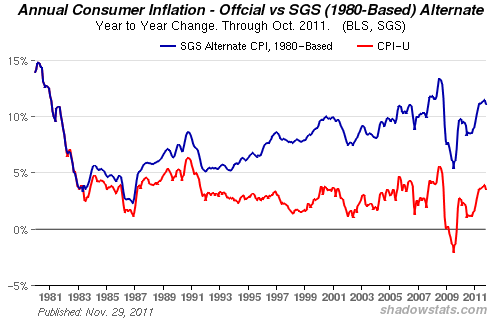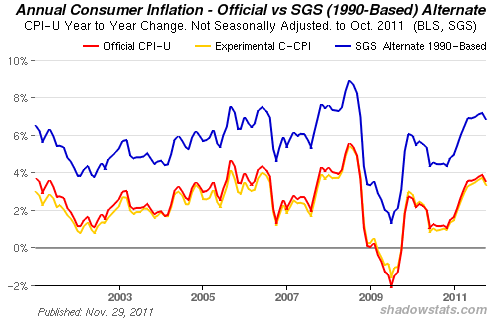Many of us on the internet have written about how growth is dead and that the GDP growth we are now experiencing (minor as it is) is due to massive deficit spending at a rate of about $1.6 trillion per year. Once you sit down and do the math, the unsustainability of almost our entire society is evident. A collapse is inevitable and obvious to anyone who extrapolates the math out just a few years.
We’ve already taken a look at the unsustainability of exponential growth, but let’s examine just a few of the other unsustainable pressures in our society.
Health Care Cost for the Federal Government
Health care cost for the Federal Government was $55 billion in 1980. The cost has increased by a little more than 9 percent a year and as of 2010 is now about $800 billion a year. If you extrapolate this rate of increase long enough, collapse is inevitable. There’s no way economic growth can match 9 percent a year. In 2020, it will have risen to around $1.8 trillion. By 2030, we’re approaching $5 trillion a year.
This won’t happen because it can’t happen. The system will have collapsed long before we spend $5 trillion a year. So health care costs are headed toward a brick wall and fast. Promises that were made to people now approaching retirement can’t be met. Cutting these programs a little bit won’t be sufficient. Considering the political climate in Washington, we can expect this train to continue to pick up speed until it derails. Meanwhile, private cost for health care have increased as well. In 2007, 62 percent of bankruptcy cases were caused by medical bills and of those, 78% had medical insurance. This has unsustainability written all over it.
Inflation
While wage inflation has been flat or deflationary, prices for all sorts of goods are continuing higher. According to the Bureau of Labor Statistics, annualized inflation is currently at 3.5 percent, with core inflation (which excludes energy and food) being even lower. But methodologies for studying inflation have changed over the last few decades. If we were to measure inflation today in the same way we did in 1980, inflation would be about 11 percent! If we measured inflation in the same way we did in 1990, it would be about 7 percent. Note the divergence on these charts, courtesy of ShadowStats.com:


“After former Federal Reserve Chairman Paul Volcker was appointed in 1979, the consumer price index surged into the double digits, causing the now revered Fed Chief to double the benchmark interest rate in order to break the back of inflation. Using the methodology in place at that time puts the CPI back near those levels.”
So while Paul Volker thought inflation was high enough to use emergency tightening actions by the Fed in 1980, Fed Chairman Ben Bernanke considers this low enough to justify keeping interest rates low and is reportedly even considering more Quantitative Easing which will force inflation higher. Either Bernanke actually believe his false statistics or does he simply not care. How bad is inflation at these levels? Let’s assume inflation will continue at these averages for the next 10 years.
If Bernanke is right and inflation is at 3.5 percent annualized inflation, a person making $32,000 will need to make about $45,000 in 2020 to maintain the same purchasing power. But if the measurement of inflation we used in 1990 is to be trusted, a person will need to make $62,000 to have the same purchasing power. If we use the methodology used in 1980, a person would need to make an astonishing $90,000 just to maintain the same purchasing power they do today.
Essentially, in less then 10 years you will need to triple your income in order to maintain the same standard of living. Which measurement is to be trusted, the one that is low and allows the Federal Reserve to justify pumping up asset prices for banks and corporations in the stock market or the ones that paints a graver picture of a government out of control? Even if you choose to be cautious and average the difference, do you expect to double your income in the next 10 years?
US Public Debt and Interest on the Debt
This is the one most people focus on and its arguably the most immediate. As of this writing, the national debt is about $15.1 trillion. The annual deficit is about $1.6 trillion. The CBO expects US debt to reach $17.6 trillion in 2015, but this assumes unrealistic economic improvement. Maintaining the same economic output and barring a bond crisis or a change in fiscal policy, in three years US debt will reach well over $20 trillion. (Do the math yourself. I’m underestimating to be generous.)
At those rates, US debt will double by 2020. As the debt expands, so does the amount of interest paid on that debt and due to the insane monetary policy of the modern world, that interest is paid directly to banks. (Instead of creating our own “free” money, we lend it to the banks, who leverage it back to us at a higher interest rate. The result is that the banks are subsidized by our debt.)
Interest paid on the debt in 2012 is expected to be about $500 billion. The CBO estimated in 2009 that interest cost will quadruple in the next 10 years, eventually consuming 1/5th of all revenues. Consider this graph:
The goal of the recently failed Super Committee was to cut a measly $120 billion a year or $1.2 trillion over 10 years, and they still couldn’t do it. Even if they had succeeded, do you know what the deficit will be over the next 9 years at current rates? Almost $13 trillion. There’s good reason to believe that interest rates will increase in time which could cause a crisis overnight.
Energy Demand
While debt projections are easy to figure out, we have to rely on experts to explain the seriousness of the coming energy crisis. Even international experts who used to downplay the dangers of peak oil, have now concluded that cheap easy access to oil is drying up. Meanwhile, the Department of Energy notes that demand from the developing world is set to steadily and significantly increase, even as the already industrialized world succeeds in cutting back its use.
How fast is the cheap oil running out? Consider that if you are 22 years old, half of all the oil that has ever been pumped has been pumped in your short life.
Conclusion
What does this collapse mean? When and how will it happen? We have yet to hear a convincing time line that would seem to take all of these disparate influences in to account. In some cases, they are contradictory. For example, demand for oil is predicated on a robust global economy, which seems increasingly unstable going forward. This would soften the landing that a peak oil crisis might cause, but who’s looking forward to living in a permanent state of economic depression?
In the meantime, experts project that investment will continue to come to the US as Europe and Japan weaken, but eventually, we will have to deal with these problems. Kyle Bass of Hayman Capital Management notes the likelihood of a bond crisis after that time will be significant.
The point is, despite what commentators and presidential candidates have been communicating, there’s good reason to worry about these future problems. Couple that with our belief that growth is dead, and you’ve got a good setup for global war, but that’s a discussion for another time.


